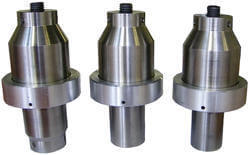We are a top-notch organization, engaged in providing Ultrasonic Booster.

An ultrasonic booster, also known as an ultrasonic amplitude transformer or ultrasonic horn, is a device used to amplify or modify the amplitude of ultrasonic vibrations generated by an ultrasonic transducer. It is commonly used in ultrasonic cleaning, welding, cutting, and other industrial applications where a higher amplitude or focused energy is required. Here’s how an ultrasonic booster typically works:
Ultrasonic Transducer: The ultrasonic booster is typically connected to an ultrasonic transducer, which is responsible for generating the initial ultrasonic vibrations. The transducer converts electrical energy into mechanical vibrations using piezoelectric elements or other mechanisms.
Amplitude Amplification: The ultrasonic booster is designed in a specific shape and size to amplify or modify the amplitude of the ultrasonic vibrations generated by the transducer. It acts as a mechanical amplifier that transforms the low-amplitude vibrations from the transducer into higher-amplitude vibrations at the output.
Resonance Frequency: The ultrasonic booster is often designed to have a specific resonance frequency that matches the operating frequency of the ultrasonic system. This resonance frequency helps optimize the energy transfer and amplification of the vibrations.
Horn Design: The ultrasonic booster is typically in the form of a horn or a tapered structure. The shape and dimensions of the horn are carefully engineered to achieve the desired amplitude amplification or energy focus. The length, cross-sectional area, and taper angle of the horn influence the mechanical advantage and energy transmission.
Acoustic Impedance Matching: Ultrasonic boosters are designed to have good acoustic impedance matching between the transducer and the load (such as a cleaning tank or welding interface). This matching ensures efficient transfer of ultrasonic energy from the booster to the working medium, minimizing energy loss and maximizing the performance of the system.
Focused Energy: In certain applications, ultrasonic boosters can be designed to focus the ultrasonic energy at a specific point or area. This is achieved by shaping the horn to concentrate the energy and provide a more concentrated and intense ultrasonic field.
Material Selection: Ultrasonic boosters are commonly made of materials that exhibit high mechanical strength, such as titanium, aluminum, or stainless steel. The material selection depends on factors such as the required mechanical properties, frequency range, and compatibility with the working environment.
Ultrasonic boosters offer several benefits in industrial applications. They can increase the power and intensity of ultrasonic vibrations, improve the cleaning efficiency, enhance welding or cutting performance, and enable precise control and focus of energy. The selection of an appropriate ultrasonic booster depends on the specific application requirements, including the desired amplitude amplification, frequency range, and the properties of the working medium. Consulting with manufacturers or suppliers of ultrasonic equipment can provide guidance on selecting the right ultrasonic booster for a particular application.
